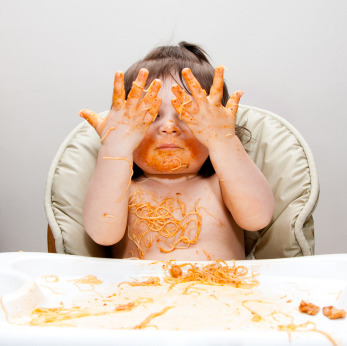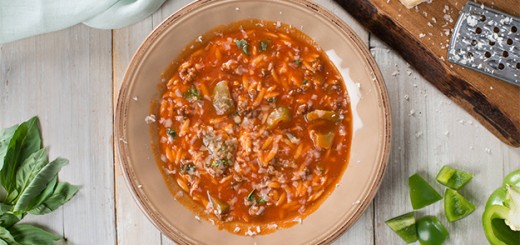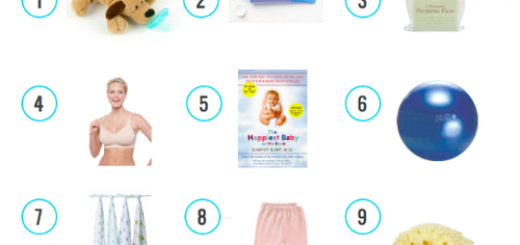Big Qs: What are your essentials for transitioning to solids?
Jessica Solloway is a first time mom to 9-month old Olivia. She lives in Washington, D.C. and is an Account Director at Ogilvy Public Relations Worldwide. In her free time, she writes for women’s websites, explores the city with her family, and sings The Wheels on the Bus. You can learn more about her life as a mom on her blog, The Savvy Mrs.

Starting solid foods is a learning process for parents and babies. It takes lots of trial, error and laundry detergent to find your groove. As if you don’t already have enough baby stuff taking over your house … here’s what you need to make the mealtime magic happen:
Bibs. Don’t bother with cute and/or expensive bibs. They get destroyed within .00004 seconds. Sometimes between bites my daughter just shoves the bib in her mouth. I’m like, “Slow your roll, sister.” But she ignores me. I use green sprouts Waterproof Absorbent Terry Bibs. Aden + anais Muslin Burpy Bibs do double duty. And these Bumkins Waterproof Sleeved Bibs are no joke.
Utensils.Munchkin products are light, cheap and BPA free. More importantly, if you’re in the path of a flying bowl, it won’t hurt. “So you don’t like peas? Message received.”
Highchairs. I have the Graco Blossom, but we started feeding my daughter in a small Prince Lionheart seat before moving up to the big leagues.
On the Go Stuff. Chicco Caddy Hook On Chairs or the Fisher Price Healthy Care Booster Seat are perfect for travel or keeping at the grandparents.
Share your essentials for transitioning to solids here!
Prepare to turn that spoon into an airplane, my friends…
Babies start solids anywhere from 4-6 months. The face my daughter made during her first bite of oatmeal was priceless. You’d think we gave her lemon juice. The bib, the bowl and spoon rocked her world. She was far more interested in studying the mystical buckles of her seat than actually eating. If we were lucky, we got a few bites at each meal. Most of it ended up on everyone’s faces and clothes.
It’s recommended to introduce one new food at a time, for at least four days, to spot an allergic reaction. Breastmilk or formula is still their main source of nutrition, so don’t stress if they’re not eating too much food at the beginning.
I started out with Earth’s Best Organic fruit and veggies. They have great starter kits with all the basics. I’m also a fan of Ella’s Kitchen Organic Baby Food and Happy Baby, which are great for tossing in your diaper bag when you’re out and about.
To make your own purees, just steam or bake fruits and veggies, then blend in a food processor. Baby food makers, like the Beaba, do everything in one contraption. Spend a couple hours over the weekend whipping up big batches to freeze. These containers are wonderful for freezing and then using for serving when you’re on the go. A standard ice cube tray works well too.
Tips & Tricks
When my daughter was just starting out with food, I set up a few “friends” (stuffed animals) at the table and pretended to feed them too. It helped keep her interested in eating! Poor Minnie Mouse took one for the team and will forever have a squash stain on her face.
Don’t try to feed a baby when they’re really hungry. If they’re new to eating, and more stays on their face than goes in their tummy, they’ll get frustrated. Start with a little breastmilk or formula first. And if your baby is really tired, a feeding probably won’t go well. So, time it accordingly.
If at first you don’t succeed, try, try again. It may take several experiences before they decide that green stuff isn’t so bad.
And don’t worry, you’ll get used to smelling like carrots.
What are your feeding essentials? Create and share your weeList here.



